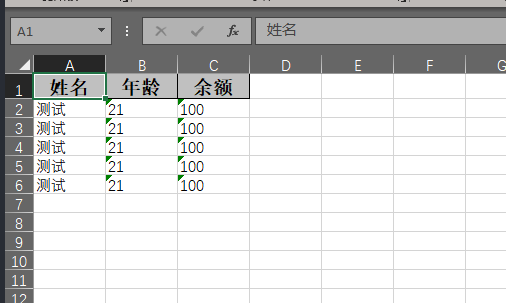附赠 EasyExcel 的官方文档
最近用到了需要使用 Excel 的 InputStream 流转化为 Java 实体类,然后再进行一些业务上的操作,这边稍加学习了之后也做了一些整理:
本次所用到的依赖:
1
2
3
4
| implementation 'org.projectlombok:lombok:1.18.20'
implementation group: 'cn.hutool', name: 'hutool-all', version: '5.7.16'
implementation('com.alibaba:easyexcel:2.2.6')
implementation 'com.google.protobuf:protobuf-java:4.0.0-rc-2'
|
# 首先需要建立一个和 Excel 相对应的实体类
1
2
3
4
5
6
7
8
9
10
11
12
13
14
15
16
| @Data
public class IndexOrNameData {
@ExcelProperty(index = 2)
private Double doubleData;
@ExcelProperty("字符串标题")
private String string;
@ExcelProperty("日期标题")
private Date date;
}
|
# 监听器
使用解析功能时需要使用到 easyExcel 提供给我们的一个监听器
![]()
所以我这边选择的是继承 AnalysisEventListener 类,是一个通用泛型类
有个很重要的点 ExcelListener 不能被 spring 管理,要每次读取 excel 都要 new , 然后里面用到 spring 可以构造方法传进去
1
2
3
4
5
6
7
8
9
10
11
12
13
14
15
16
17
18
19
20
21
| @Slf4j
public class ExcelListener<T> extends AnalysisEventListener<T> {
private List<T> dataList = new ArrayList<>();
@Override
public void invoke(T data, AnalysisContext context) {
log.info("解析到一条数据:{}", JSON.toJSONString(data));
dataList.add(data);
}
@Override
public void doAfterAllAnalysed(AnalysisContext context) {
log.info("所有数据解析完成!");
}
public List<T> getDataList() {
return dataList;
}
}
|
# 工具类泛化使用
1
2
3
4
5
6
7
8
9
10
11
12
13
14
15
16
17
18
| public class ExcelUtil{
public static <T> List<T> readExcel(InputStream excelInputStream, Class<T> clazz){
ExcelListener<T> excelListener = new ExcelListener<>();
ExcelReader excelReader = EasyExcel.read(excelInputStream, clazz, excelListener).build();
if (ObjectUtil.isNull(excelReader)){
return new ArrayList<T>();
}
List<ReadSheet> readSheetList = excelReader.excelExecutor().sheetList();
for (ReadSheet readSheet : readSheetList) {
excelReader.read(readSheet);
}
excelReader.finish();
return Convert.toList(clazz,excelListener.getDataList());
}
}
|
由于第二个参数 clazz 的原因,只要传入了相应的泛型类,就会返回相应类型的 List
1
2
3
4
5
6
7
8
9
10
11
| public static void main(String[] args) {
File file = new File("D:\\Download\\test.xlsx");
try {
InputStream fileInputStream = new FileInputStream(file);
List<IndexOrNameData> driverBlackListExcels = ExcelUtil.readExcel(fileInputStream, IndexOrNameData.class);
System.out.println(driverBlackListExcels);
} catch (FileNotFoundException e) {
e.printStackTrace();
}
}
|
![]()
# JavaList 封装为 Excel 返回
上面已经介绍完如果读取上传的 Excel 文件,接下来需要介绍如何将 List 数据输出为 Excel 文件
一样需要建立一个和 Excel 对应的实体类:
1
2
3
4
5
6
7
8
9
10
11
12
13
14
| @Data
public class TestExcelPojo {
@ExcelProperty("姓名")
private String name;
@ExcelProperty("年龄")
private String age;
@ExcelProperty("余额")
private String money;
@ExcelIgnore
private String ignore;
}
|
这边有一个注意点,就是 @ExcelProperty 是把你的 Excel 头换成了对应的值,但是存在于这个实体类中属性都会被解析出来放到输出的 Excel 文件中.
然后使用 EasyExcel 提供的方法来进行数据的写,一下是用例代码:
1
2
3
4
5
6
7
8
9
10
11
12
13
14
15
16
17
18
19
20
21
22
23
24
25
26
27
28
29
30
31
32
33
34
35
| @SpringBootTest
public class TestEasyExcel {
@Value("${download.tmpPath}")
private String tmp;
@Test
void Context01(){
ArrayList<TestExcelPojo> pojoArrayList = new ArrayList<>();
TestExcelPojo pojo = new TestExcelPojo("测试", "21", "100");
pojoArrayList.add(pojo);
pojoArrayList.add(pojo);
pojoArrayList.add(pojo);
pojoArrayList.add(pojo);
pojoArrayList.add(pojo);
String fileName = tmp + File.separator + IdUtil.simpleUUID() + ".xlsx";
ExcelWriter excelWriter = null;
try {
excelWriter = EasyExcel.write(fileName,TestExcelPojo.class).build();
WriteSheet writeSheet = EasyExcel.writerSheet("模板").build();
excelWriter.write(pojoArrayList,writeSheet);
FileInputStream fileInputStream = new FileInputStream(fileName);
ByteString bytes = ByteString.readFrom(fileInputStream);
} catch (Exception e) {
e.printStackTrace();
}finally {
if (excelWriter != null) {
excelWriter.finish();
}
}
}
}
|
![]()


